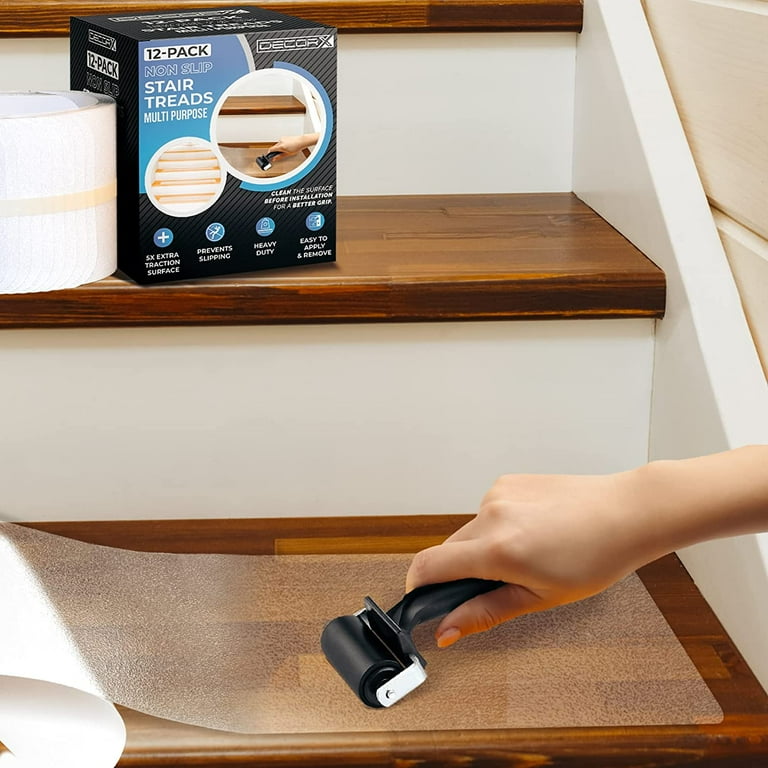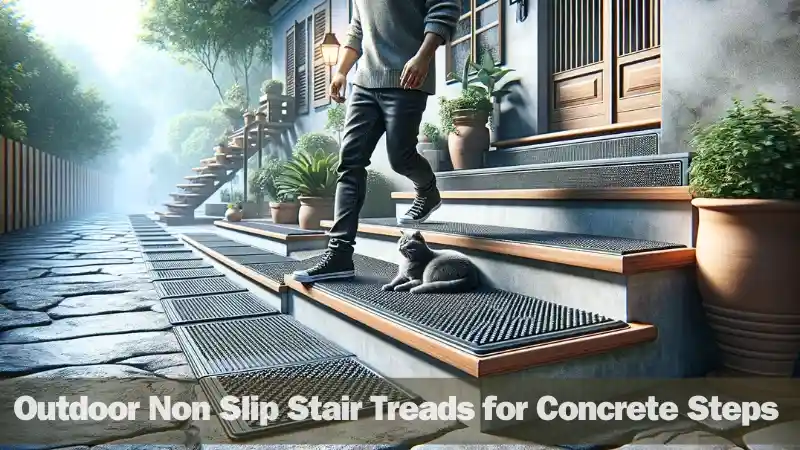Outdoor Non Slip Stair Treads for Concrete Steps: Safety First!
Outdoor non-slip stair treads enhance safety on concrete steps, providing traction in all weather conditions. These treads prevent slips and falls, crucial for both residential and commercial properties.
Outdoor staircases, especially those made of concrete, can become perilous in wet or icy conditions. Non-slip treads serve as an essential safety feature, offering stability and peace of mind. They come in various materials, including rubber and heavy-duty composites, designed to withstand the elements and heavy foot traffic.
Ideal for homes, schools, and businesses, these treads not only improve grip but also add to the lifespan of the stairs by protecting the surface from wear. Easy to install, they are a cost-effective solution to enhance stair safety and can be a smart investment in accident prevention, crucial for maintaining a safer environment on your property.

Credit: www.walmart.com
Importance Of Non Slip Solutions For Concrete Steps
Concrete steps turn slippery when wet, posing a risk to everyone. Non Slip solutions, like outdoor or best stair treads, can conquer these risks. They are a safe, efficient, and cost-effective way to protect all from accidents on stairs.
Risks Of Slippery Stairs
Slippery stairs can cause serious injuries. A simple misstep may lead to fractures or sprains. Elderly people and children are especially at risk. The risks multiply in wet and frosty conditions.
- Falls: The main danger of slippery stairs. Even a small slide could lead to a major fall.
- Injuries: Falls often result in broken bones, sprains or worse.
- Accidents: Slip accidents harm more than the victim. They may also result in property damage
Advantages Of Non Slip Stair Treads
Non Slip Stair Treads offer solutions to these risks. They provide safe footing on slippery concrete stairs. Beyond safety, they offer several other benefits.
| Advantages | |
|---|---|
| 1 | Prevent accidents: These treads increase traction, reducing the risk of slipping or falling. |
| 2 | Cost-effective: Compared to other safety measures, non slip treads are affordable and long-lasting. |
| 3 | Easy to install: Anyone can fit these treads on stairs. No need for professional help. |
| 4 | Durable: Quality non slip treads can withstand heavy foot traffic, rain, and snow, maintaining safety for years. |
The health and financial risks of slippery stairs are clear. Safe and durable, non slip stair treads guard against these dangers. They are a simple solution to this common hazard.
Materials And Textures That Prevent Slips
A range of materials and textures can help in rendering concrete stairs slip-proof. This post explores two essential and effective types: rubber treads and textured tapes or paints. Both materials provide grip and reduce slip risks.
Rubber Treads
Rubber treads serve as a boon to safety. They deliver traction and cushioning
- Tough yet comfortable: Rubber treads are both robust and inviting underfoot.
- Anti-slip property: Their intrinsic anti-slip properties add safety even in wet conditions.
- Easy Install: A simple adhesive can fix these treads to your concrete stairs.
They resist wear and tear, ensuring optimal safety for a long time.
Textured Tape And Paint Options
For a less noticeable approach, use textured tape or paint. They’re easy to implement and highly effective.
- Textured Tape:
- Textured tapes provide excellent grip, perfect for high-traffic stairs.
- Anti-slip Paint:
- Crafty homeowners may prefer anti-slip paint. It provides a uniform, seamless appearance.
Both options offer water and weather resistance. They increase the safety factor of your concrete steps.
Installation Tips For Maximum Grip
Ensuring a safe walk up your concrete steps means installing outdoor non-slip stair treads correctly. This guide walks you through tips for maximum grip so that every step is a secure one.
Surface Preparation
Begin with a clean slate. Clear any debris, dust, or loose particles from the concrete steps. Use a stiff-bristled brush to scrub the surface and a hose or pressure washer to remove any stubborn dirt. Make sure the steps are dry before moving on.
A properly prepared surface ensures the treads adhere well and won’t shift or bubble. Check the surface for cracks or damage and repair these issues for a smooth installation process.
Securing Treads Effectively
Choose the right adhesive. Not all glues are suitable for outdoor conditions or concrete surfaces. Look for a heavy-duty, weather-resistant adhesive that’s designed for exterior use. Read the manufacturer’s instructions carefully before applying.
- Measure twice, cut once. Ensure each tread fits the step perfectly by measuring the space and cutting the tread to size, if necessary.
- Press firmly in place. Once you position the tread, apply pressure evenly across the surface to help the adhesive bond. Consider using a rubber mallet for this step.
- Allow time to set. Wait for the adhesive to cure completely before using the stairs. Check the product’s guidelines for the recommended cure time.
| Step | Action | Notes |
|---|---|---|
| 1 | Clear and Clean | Remove debris and clean surface |
| 2 | Choose Adhesive | Use outdoor, weather-resistant glue |
| 3 | Cut to Fit | Measure step and cut tread accordingly |
| 4 | Apply and Press | Position tread and apply pressure |
| 5 | Let Set | Wait for adhesive to cure before use |
Safety comes first. While following these steps, wear appropriate protective gear. Gloves and a mask might be necessary especially if you’re using chemical adhesives. Remember, taking time to install each tread properly makes your steps safer in the long run.

Credit: rubberflooringexperts.com
Maintenance For Long-lasting Safety
Maintenance for Long-Lasting Safety is quintessential when installing outdoor non-slip stair treads on concrete steps. Without proper care, even the most durable stair treads may fail to prevent slips and falls. Let’s explore the best maintenance practices to ensure your outdoor stair treads remain safe and effective for years to come.
Regular Cleaning Guidelines
To maintain the non-slip features of your stair treads, regular cleaning is vital. Here is a simple yet effective routine:
- Sweep debris with a stiff-bristle brush weekly.
- Wash with a mild detergent and water mixture monthly.
- Rinse thoroughly to avoid leaving slippery residues.
Mildew or algae? Use a vinegar and water solution to scrub it away gently. Ice or snow? Use salt or calcium chloride to safely melt it without damaging the treads.
Wear And Tear Assessment
Stair treads face wear and tear over time. It’s essential to assess them periodically. Here’s a checklist for you:
| Checklist Item | Action |
|---|---|
| Surface Cracks | Fill minor ones with concrete caulk; replace if large. |
| Edging | Ensure it’s intact; reattach or replace if needed. |
| Tread Adhesion | Check for loose corners or sides; reapply adhesive if necessary. |
Pro tip: During your assessment, look for changes in texture or color, which can signal potential safety issues.
Choosing The Right Non Slip Option For Your Stairs
Choosing the Right Non Slip Option for Your Stairs plays an essential role in your safety and comfort. You need stair treads that will offer both function and durability. From assessing staircase conditions to matching treads with the environment, this guide helps you make an informed decision.
Assessing Staircase Conditions
Begin by evaluating your concrete stair’s condition. Check for cracks, uneven steps or damaged edges. If considerable repairs are needed, consider fixing these issues before installing non slip stair treads.
- Examine the steps for visible signs of wear and tear.
- Measure every step to ensure even tread installation.
- Identify high traffic areas that require additional protection.
Matching Treads To The Environment
Match your stairs’ conditions to the most suitable non slip stair tread. Consider the environment. Outdoor concrete steps endure harsh weather, requiring robust, weather-resistant treads.
| Stair Conditions | Non Slip Tread Options |
|---|---|
| High Traffic | Heavy-duty Rubber Treads |
| Rough Weather | Weather-resistant Polypropylene Treads |
| Wet Conditions | Anti-mold and Water-resistant Treads |
Note: Do test a small area with the chosen tread before full-scale installation. It helps evaluate performance and ensure it meets your expectations.
Legal And Compliance Aspects
not only for ensuring safety but also for complying with laws and regulations related to property standards.
Building Codes And Safety Regulations
Building codes and safety regulations play significant roles in shaping the use of non-slip stair treads.
All areas must meet specific requirements to guarantee safety for users . Avoiding non-compliance is paramount as it can generate severe consequences.
- The International Building Code (IBC) imparts specific requirements for stairs.
- These regulations include tread depth, rise height, and slip resistance.
- Such rules are in place to reduce the risk of fall-related injuries.
Non-Slip stair treads for concrete steps meet these requirements, significantly enhancing safety.
Liability Concerns For Property Owners
As a property owner, you have the responsibility to ensure the safety of those who use your stairs.
Failure to provide safe passage can lead to legal implications and possible lawsuits.
- If a person gets injured due to fall, they can sue the property owner for negligence.
- Non-compliance with building codes also leads to hefty fines.
Utilising non-slip stair treads is not just a safety measure, but a legal safeguard . It prioritizes user safety, showing you have taken necessary precautions to prevent accidents.
Frequently Asked Questions For Outdoor Non Slip Stair Treads For Concrete Steps
How Do You Make Outdoor Concrete Stairs Non-slip?
To make outdoor concrete stairs non-slip, apply a textured anti-slip tape or coat them with non-slip paint. Alternatively, use a concrete sealer with added grit for traction. Installing rubber or metal stair treads can also increase slip-resistance.
What Can I Put On Slippery Concrete Steps?
Apply anti-slip tape or grip paint to enhance traction on slippery concrete steps. Rubber stair treads are also an effective, non-slip solution.
What Do You Put On Outdoor Concrete Steps?
For outdoor concrete steps, apply anti-slip adhesive strips or use concrete paint with non-slip additives. Ensure regular cleanings to prevent algae buildup. Use a sealer for prolonged durability and protection against weather elements. Always remember safety is paramount when walking on these steps.
What Is The Best Tread For Outdoor Stairs?
The best tread for outdoor stairs is non-slip rubber. Rubber provides grip, durability, and weather resistance. It’s essential for safe, year-round outdoor stair use. Opt for a textured surface for added traction.
Conclusion
Safe navigation on outdoor stairs is crucial. Non-slip stair treads for concrete steps offer users that security. They are not only durable, but also enhance grip under various weather conditions. Optimise safety around your home and office with this easy-to-install, low-maintenance solution.
Make every step forward a secure one.


